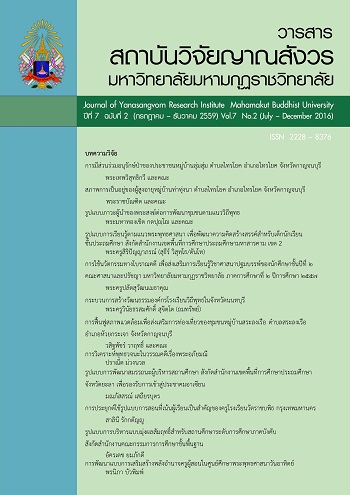AN APPLICATION OF CHILD CENTER TEACHING MODEL OF TEACHERS IN RATCHABORPIT SCHOOL, BANGKOK
Main Article Content
Abstract
The objectives of this research were as follows: 1) To study on application of teaching model for learner center of teachers in Wat Rajaborpit school, Bangkok, 2) to compare on application or integration of teaching model for learner center of teachers in Wat Rajaborpit school, Bangkok in terms of sexes, degrees of education and teaching experiences as differently and 3) An opinion toward application of teaching model for learner center of teachers in Wat Rajaborpit school. Bangkok. The population were composed of teachers in Wat Rajaborpit school, Bangkok in academic year 2014, there are about 90 persons, sample size made by Taro Yamane table’s measurement, the sample were about 73 persons, simple random sampling was used, the instrument for data collection was questionnaire which are designed by researcher based on conceptual framework, concept, theory and research work objectives, hypothesis throughout definition, to evaluate the quality of instrument, the statistics, there are two types, descriptive statistics were as follows, frequency, percentage, mean, standard deviation and deductive method were as follows, t-test and one way ANOVA. The findings were as follows: 1. The teachers in Wat Rajaborpit school had recommended on application of teaching model for learner center by overview was at more level for all aspects when considered in each aspect from more to less found that the model which are highest mean was the Sippa Model. 2. The Teacher who are different in term of sexes, degrees of education and Teaching experiences found that there were no different. 3. An application of teaching model for learner center of teachers in Wat Rajaborpit school, Bangkok can be divided as follows (1) assumption role model and (2) project work model i.e. there should provide learning activity passing on project work learning resources in community for student’s analysis and summarize for learning. (3) computer lesson i.e. there should give an opportunity to students for less plan making (4) Suppa model, there should promote for all to present work for their pride for development of them, there should have pre-test and post-test (5) co-operate learning model i.e. to promote for brain storming every time on work for giving opportunity to all students in participation on any opinion and to have group activity for all participation and harmony for activity performance.
Article Details
References
วัฒนาพร ระงับทุกข์.(2542). แผนการสอนที่เน้นผู้เรียนเป็นศูนย์กลาง. พิมพ์ครั้งที่ 2. กรุงเทพฯ : แอลพีเพรส.
ศึกษาธิการ, กระทรวง. กรมวิชาการ. (2539). การประเมินผลจากสภาพจริง. กรุงเทพฯ : โรงพิมพ์คุรุสภาลาดพร้าว.
ทิศนา แขมมณี. (2548). ศาสตร์ : องค์ความรู้เพื่อการจัดการกระบวนการเรียนรู้ที่มีประสิทธิภาพ. กรุงเทพฯ : สํานักพิมพ์แห่งจุฬาลงกรณ์มหาวิทยาลัย.
วัฒนาพร ระงับทุกข์. (2542). แผนการสอนที่เน้นผู้เรียนเป็นศูนย์กลาง. กรุงเทพฯ : แอล ที เพรส จํากัด
วิชัย วงษ์ใหญ่. (2544). กระบวนการพัฒนาหลักสูตรและการเรียนการสอน : ภาคปฏิบัติ. กรุงเทพฯ : สุวียาสาส์น.
วิชาการ, กรม กระทรวงศึกษาธิการ. (2545). การสังเคราะห์งานวิจัยเกี่ยวกับรูปแบบการจัดการเรียนรู้ที่เน้นผู้เรียนเป็นสําคัญ.
Best, John W. (1986). Reserch in Education. Englewood Cliffs. New Jersey: Prentice - Hall Inc.
D.W. & Johnson, R.T. 1991. Learning Together and Alone: Cooperative and Individualistic Learning. (5 th. ed) Englewood Cliffs, New Jersey.
Likert. (1976). New pattem of management. New York: MacMillan Publishing Co.
Taro Yamane. (1973). T Statistics. An introductory. (2 nd ed). New York: Harper & Row.


